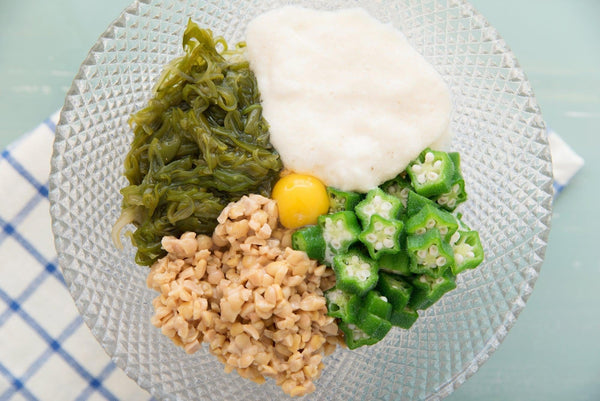
Jump to:
Slimy foods — yuk! Slippery, sticky textures are usually not a favorite in the West, but in Japan neba neba is quite popular. Neba Neba is the Japanese word for sticky, slimy foods like natto (fermented soybeans), okra, and a handful of others. This article will tell you all about these unusual (in the Western eye) foods from Japan, their health benefits, and more.
What Is Neba Neba Food?

Neba Neba foods have a slippery, slimy or sticky texture. This type of food texture may seem strange to many Westerners, but there are quite a few well-liked neba neba foods in Japan (like some seaweeds, mushrooms, natto, and more). They’re usually quite healthy and low in calories, too!
Health Benefits

Who knew that the foods people hate the most (at least in the West) might be the best for your body! Japan’s slimy foods (neba neba) have tons of health benefits. According to Genmai Koso, they are known for “. . . protecting [and] supporting the weakened stomach and intestines with digestive enzymes, and being rich in nutrients such as B vitamins that promote energy metabolism.” There are a lot of other health benefits, too, and they are listed with each neba neba food later in this article.
Some Sticky History
Neba Neba has been a popular type of food in Japan for centuries, and natto is one of the ancient ones that most people familiar with Japan have heard of. But did you know that okra is also considered neba neba?
According to Kagawa Prefecture, it came to Japan from the US and only started being grown in Japan in the mid-1900s. Many other neba neba foods have been (and continue to be) eaten in Japan, as well.
Neba Neba Foods
Okay, now for a list of the foods that we call neba neba. The slimy little darlings of Japanese cuisine. Here we go!
Natto

The first on the list has to be natto. This is probably the most famous neba neba food in Japan! If you haven’t heard of it (which would be a little surprising), it’s made of fermented soybeans.
It’s often eaten for breakfast (although not only), and it has a sticky, gooey, almost creamy texture when you stir it around and eat it. It leaves long strings of natto mucus (for lack of a better word) hanging off your chopsticks, too. The taste is sort of bitter, salty, and bean-y, and it has a strong, pungent smell, too. But if you can get past all that — you might actually like it!
The health benefits of natto are famous (at least in Japan), and there have been plenty of scientific studies on it. NHK World did a great video about it. They mention that “. . . Natto not only activates the immune system but also contains a significant amount of vitamin K2, which can suppress brain inflammation, while the substance responsible for its stickiness lowers blood sugar levels.”
Okra

Okra, isn’t that a Western food? Well actually, they say it came from Africa originally, but it ended up being eaten all over the world — including in Japan.
As far as nutrition, okra can help keep cholesterol and blood sugar under control, protect your stomach’s mucous membrane and help with intestinal health. It’s got a lot of potassium, calcium and beta-carotene, too.
You have probably tried okra before, but for those who haven’t . . . it’s got one-of-a-kind food texture. When it’s cooked it has a green bean sort of consistency on the outside and a sticky, slimy, inside with little seeds that pop open in your mouth.
This description may not be doing okra any favors, but if you like okra — you get it. If you haven’t tried it, take a chance! You can even try making a Japanese okra salad with our recipe.
Moroheiya

This is an interesting one. Moroheiya (aka mulukhiyah or ewedu) is a leafy green vegetable, but when it’s cooked it gets all gooey.
It was originally grown in Egypt, the Middle East and some other far away countries, but it eventually found its way into Japanese cuisine. According to Noodlist, it has tons of beta carotene (more than carrots) and “more vitamin B (Thiamine), B2 (Riboflavin), B6 (Pyridoxine) . . . B9 (Folate) and vitamin E than spinach, broccoli or carrots.” Plus it has calcium and fiber!
If you’d like to try making a dish with it, take a look at this moroheiya soup recipe on YouTube (with English subtitles).
Fun Fact: According to the Food Safety Commission of Japan (in Japanese), moroheiya is poisonous if eaten improperly — although rarely deadly. Just don’t eat the seeds or pods. If you buy it at the grocery store, you should be fine.
Yamaimo

Like yams? How about mountain yams? Well, Japan has you covered in that department with yamaimo (also spelled as two words, yama imo). This is one of Japan’s most delicious and unique slimy vegetables!
Yamaimo can actually be eaten raw. According to Eat-Japan, it’s often made into a paste (called tororo — yam paste) “which can be placed on wheat rice to make mugitoro gohan.” It can also be served with diced tuna (called yamakake) or with soba noodles (yamakake soba).
Yamaimo also has digestive enzymes (called diastase and amylase) and a protective ingredient for the stomach called mannan. The National Institutes of Health say, “Mannans improve the texture and appeal of food products and offer numerous health benefits such as control of obesity and weight control in general, prebiotic benefits, constipation alleviation, the prevention of diarrhea . . .” and much, much more.
Mekabu & Mozuku

Mozuku and Mekabu are both seaweeds that, although they look almost alike, are actually different foods. According to Setagaya Natural Foods (in Japanese), mekabu is a part of the wakame plant (a type of kelp) — specifically the flowering part. Mozuku is a brown Okinawan seaweed.
What makes these seaweeds sticky (and healthy) is two things: fucoidan and alginic acid. Fucoidan is supposed to help activate immune cells, and alginic acid is sometimes used to treat gastroesophageal reflux disease and indigestion.
Mozuku and Mekabu are also rich in calcium, iodine, and dietary fiber. Check out more health benefits of these seaweeds and others in our article about different seaweed varieties.
Note: Another neba neba seaweed you might want to try is by a company called Izuri — Neba Neba Konbu. This one is sticky, has a nice aroma and is somewhat sweet. It’s also shaved into fine strands.
Nameko

Mushrooms are really popular in Japan (come to think of it, they are in the West, too, right?) Anyway, there is one mushroom that is a bit different from the others — nameko. Nameko is the neba neba (slimy) mushroom. Why people decided to eat it in the first place, who knows (it looks a little scary), but it tastes great.
This is a clustered mushroom that has a nutty sort of flavor. It also has vitamin D (like many other mushrooms) that helps to reduce inflammation and regulate blood sugar (among other benefits). Specialty Produce wrote a detailed article about these mushrooms that you should read if you want to know more about them.
Neba Neba Recipes
There are lots of ways to prepare Japanese neba neba foods — it’s really up to what you like and what recipe you’re using. Here are a few recipes you might want to try.
Neba Neba Don

Don stop me now! (Queen reference) But anyway, what is a don? A don is a bowl of rice with something on top (usually called a donburi or rice bowl). There are many kinds of donburi topped with meat, veggies, and more (like katsudon, oyakadon and gyudon, for example).
Neba neba don is topped with — you guessed it — neba neba foods! You’ll see various toppings on it like seaweed, okra, natto and even raw eggs. Try it for yourself with this I Love Natto recipe.
Tororo Jiru

Tororo jiru is a mountain yam (yamaimo) soup made by grating the yams into a paste and adding various seasonings. It’s got a rich flavor and is pretty sticky!
Try this recipe from an old cookbook (really nostalgic). There are a couple of Japanese words in this recipe, but you should be able to pull it off. Just in case you have trouble, suribachi is a mortar bowl, shoyu is soy sauce and nori is that paper-thin seaweed.
Note: “Gourmet powder” (MSG) is listed as an ingredient — it’s very umami, but if you don’t want to use it, try a broth powder or these Foodchamp substitute suggestions.
Nameko Shiru

Not just any mushroom soup, this is a neba neba mushroom soup. The mushrooms give it a creamy texture with an earthy, nutty flavor. You can find some ready-to-make red miso soup with nameko mushrooms here on Japanese Taste!
Neba Neba Salad

This salad is the combination of a lot of slippery, slimy Japanese foods all in one. Highly recommended if you like these sorts of food textures. It usually has okra, natto, yamaimo and sometimes raw egg. Here’s a recipe for it on YouTube. They top it with bonito flakes.


0 comments